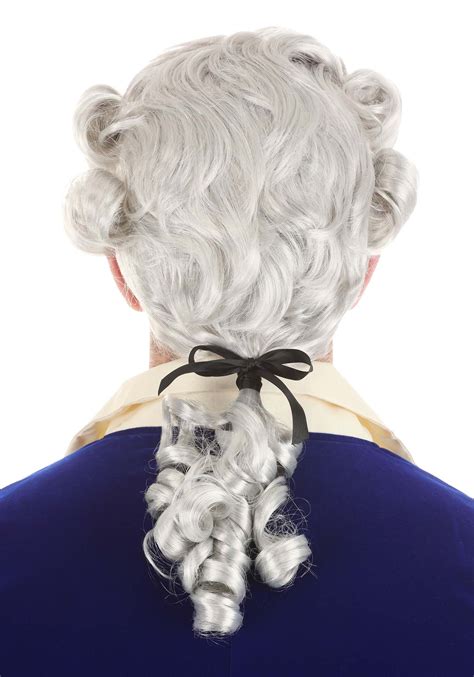A Timeless Symbol of Nobility and Elegance
The classical powdered wig has captivated imaginations and adorned historical figures for centuries. From the grand courts of Europe to the halls of justice, these elaborate hairpieces have symbolized status, power, and fashion.

Historical Origins: A Journey through Time
The powdered wig emerged in the mid-17th century as a fashionable statement among the French aristocracy. King Louis XIV, known for his extravagant court and personal grooming, popularized the fashion.
By the 18th century, powdered wigs had become a widespread phenomenon across Europe and North America. They were worn by both men and women, with varying styles and embellishments.
The Art of Wig-Making: A Labor of Intricate Skill
Creating a classical powdered wig was a meticulous process that required specialized craftsmanship. Human hair, animal hair, or a combination of both was used to create wigs that were often incredibly elaborate and adorned with ribbons, feathers, and lace.
Types and Styles: A Wide Array of Classifications
Classical powdered wigs came in various types and styles, each designed to suit different preferences and social occasions.
- Full-bottomed wigs: The epitome of grandeur, these wigs featured a voluminous, cascading style that reached down to the shoulders.
- Ramillie wigs: Smaller and less elaborate than full-bottomed wigs, Ramillie wigs were often worn by military figures.
- Tie wigs: These wigs were tied at the back of the head, creating a more natural look.
- Queue wigs: For men, queue wigs featured a long ponytail that was tied with a ribbon or bag.
The Process of Powdering: A Transformation of Color
Powdered wigs were typically dusted with white powder, which was initially made from wheat flour or rice starch. Later, more sophisticated powders were developed using talc, gypsum, or starch.
The Significance of Powdered Wigs: A Reflection of Society
Powdered wigs not only served as fashion accessories but also carried social and political significance.
- Status and hierarchy: The size and style of a wig indicated the wearer’s status and position in society.
- Grooming and hygiene: In an era where bathing was infrequent, powdered wigs provided a semblance of cleanliness.
- Cosmetic enhancement: The powder helped to conceal thinning hair or baldness, while the wig itself could be used to create an illusion of volume and height.
Modern Revival: A New Era of Appreciation
In recent decades, there has been a renewed interest in classical powdered wigs. They have become popular for historical reenactments, costume dramas, and fashion shoots.
Benefits and Importance: Why Powdered Wigs Matter
Classical powdered wigs offer a unique combination of aesthetic and historical significance.
Benefits:
- Preservation of history: Powdered wigs provide a tangible link to the past, preserving the fashion and grooming practices of previous eras.
- Cultural enrichment: They contribute to a deeper understanding of the customs and customs of our ancestors.
- Artistic inspiration: Powdered wigs are a source of inspiration for fashion designers, makeup artists, and costume designers.
Tips and Tricks: Mastering the Art of Powdered Wigs
For wearers of modern powdered wigs, here are some tips to ensure a successful hairpiece experience:
- Choose the right wig: Select a wig that matches your hair color and style preferences.
- Apply the powder evenly: Use a soft brush or puff to distribute the powder throughout the hair, avoiding clumping.
- Create a natural look: Avoid applying too much powder, which can make the wig stiff and unnatural.
- Protect the wig: Store the wig in a cool, dry place to prevent damage from heat and humidity.
Applications beyond Fashion: A Spark of Innovation
The concept of powdered wigs can inspire new applications in various fields:
- Cosmetics: The use of powder to enhance hair volume and conceal imperfections can be applied to modern hair products.
- Hair care: The techniques used to create powdered wigs can be adapted to develop innovative hair styling techniques.
- Healthcare: The study of hair powdering can provide insights into historical sanitation practices and their impact on public health.
Tables for Reference
| Wig Style | Description | Era |
|---|---|---|
| Full-bottomed | Voluminous, cascading style | Mid-17th to 18th century |
| Ramillie | Smaller, less elaborate | 18th century |
| Tie | Tied at the back of the head | 18th century |
| Queue | Long ponytail with ribbon or bag | 18th century |
| Powder Composition | Year Introduced |
|---|---|
| Wheat flour or rice starch | Mid-17th century |
| Talc | 18th century |
| Gypsum | 18th century |
| Starch | 18th century |
| Benefits of Powdered Wigs |
|—|—|
| Preservation of history |
| Cultural enrichment |
| Artistic inspiration |
| Tips for Powdering Wigs |
|—|—|
| Choose the right wig |
| Apply the powder evenly |
| Create a natural look |
| Protect the wig |
